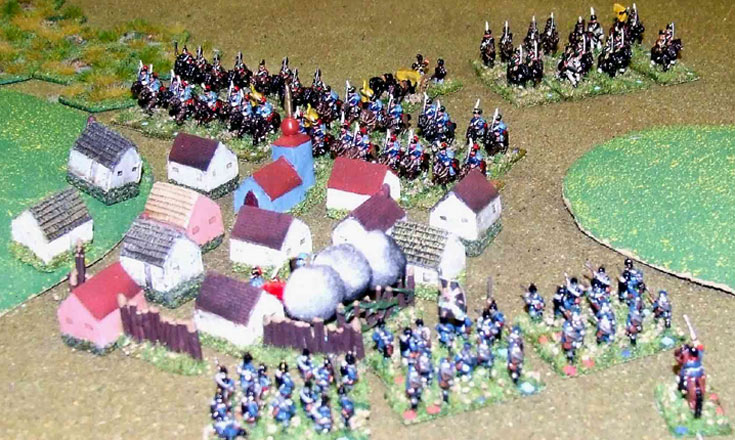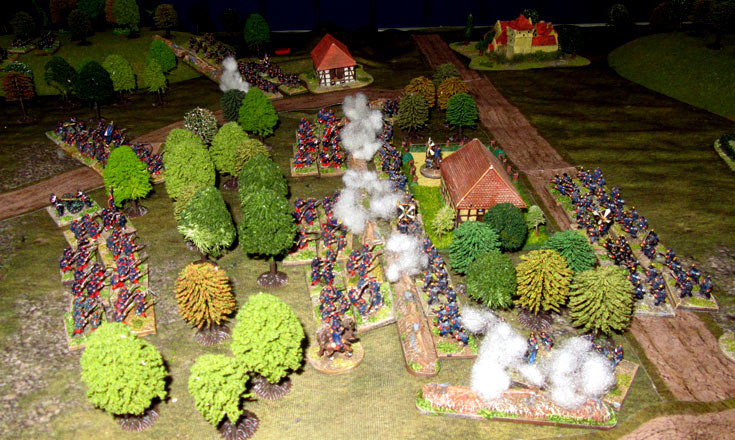
Storming the Pratberg, 1866
18th August 2011, Comments Off
Bismarck’s Wars, Field of Battle / Piquet, 10mm
When my friend Gerry “the Vet” invited me to take part in a “learning curve” game in 10mm, I admit to being underwhelmed by the prospect. However, Gerry is a nice chap, and it seemed churlish to say no, just because I’m a size snob, and was put off by the rules. In the end I’m glad I took part, as the game was a lot more fun than I’d anticipated. Besides, Gerry acted as the hard-pressed umpire, and so was there to talk everyone through the mechanisms. As this was a trial game normal scenery was dispensed with. We used basic terrain, and Gerry’s tiny figures. Gerry actually has some purpose-built terrain for this period, and for the other wars of the era (e.g. 1859 and 1870-71), but as he came straight from work he didn’t bring it in. That means we fought over a strangely barren tabletop, dominated by two low hills and a village. The aim of the game was for the Austrians to control both Sadowitz village and the hills by the end of the evening. A Prussian regiment had already deployed on the left-hand hill, the Bumptzen Heights, and a Jaeger battalion had ensconced itself in a village (Markinzch) on the Prussian right flank, in front of the right-hand hill, called the Pratberg. In the middle though, an advanced guard of Austrian hussars had seized the village of Sadowitz, had fortified it, and were prepared to hold it against all comers.
The aim of the game was for the Austrians to control both Sadowitz village and the hills by the end of the evening. A Prussian regiment had already deployed on the left-hand hill, the Bumptzen Heights, and a Jaeger battalion had ensconced itself in a village (Markinzch) on the Prussian right flank, in front of the right-hand hill, called the Pratberg. In the middle though, an advanced guard of Austrian hussars had seized the village of Sadowitz, had fortified it, and were prepared to hold it against all comers. Field of Battle is a variant of the Piquet system, which we hadn’t played before. It seemed a little odd at first, but we soon got the hang of it – sort of. I’m notoriously bad for not reading rules, and wandering off to chat to people in the middle of games. In this case though, I was keen to learn what I could about Gerry’s rules set of choice, and I stuck with it. The game involves cards, a varying number of which are available to both sides in their turn. The cards are turned over one by one, and say things like “Move”, “Artillery Fire”, Command” etc., each of which allows you to do something. If you pull a “move” one you get to roll a dice (D6, D8, D10, D12 etc.), depending on the ability of your commander. If he passes a roll-off against the opposition, then you get to move your toys. This dice-off is an important feature of Piquet, and gives the passive player something to do while the active one is turning their cards over. Shooting or melee works in a similar way.
Field of Battle is a variant of the Piquet system, which we hadn’t played before. It seemed a little odd at first, but we soon got the hang of it – sort of. I’m notoriously bad for not reading rules, and wandering off to chat to people in the middle of games. In this case though, I was keen to learn what I could about Gerry’s rules set of choice, and I stuck with it. The game involves cards, a varying number of which are available to both sides in their turn. The cards are turned over one by one, and say things like “Move”, “Artillery Fire”, Command” etc., each of which allows you to do something. If you pull a “move” one you get to roll a dice (D6, D8, D10, D12 etc.), depending on the ability of your commander. If he passes a roll-off against the opposition, then you get to move your toys. This dice-off is an important feature of Piquet, and gives the passive player something to do while the active one is turning their cards over. Shooting or melee works in a similar way. Right, back to the game. Both sides sent columns towards the empty hill – the Pratberg one on the Prussian right, while the Austrian guns pummelled the Prussians deployed on the other hill in the centre of the table – the Bumptzen Heights. Thanks to some good shooting (or bad Prussian dice) the Prussians were blown to pieces over the course of a couple of turns. This brought their parent Division closer to their breaking point, and made the Prussian Corps commander a little more nervous than he was.
Right, back to the game. Both sides sent columns towards the empty hill – the Pratberg one on the Prussian right, while the Austrian guns pummelled the Prussians deployed on the other hill in the centre of the table – the Bumptzen Heights. Thanks to some good shooting (or bad Prussian dice) the Prussians were blown to pieces over the course of a couple of turns. This brought their parent Division closer to their breaking point, and made the Prussian Corps commander a little more nervous than he was. On the right the Prussians got to the Pratbergl first, and deployed a brigade on it, backed up by divisional artillery. The division’s other brigade assaulted Sadowitz village. The first attack was driven off by the doughty Austrian hussars, but the Prussians sent in their second regiment, grouped its battalions together for a co-ordinated attack, and when the right card came they surged forward. After a brief fight the hussars were overwhelmed, and the Prussians gained control of the village. During all of this the rest of the Austrian cavalry milled around to the rear, as their commander failed to roll the dice he needed to intervene. The capture of Sadowitz put the onus on the Austrian player, who had to recapture it to have any chance of winning the game.
On the right the Prussians got to the Pratbergl first, and deployed a brigade on it, backed up by divisional artillery. The division’s other brigade assaulted Sadowitz village. The first attack was driven off by the doughty Austrian hussars, but the Prussians sent in their second regiment, grouped its battalions together for a co-ordinated attack, and when the right card came they surged forward. After a brief fight the hussars were overwhelmed, and the Prussians gained control of the village. During all of this the rest of the Austrian cavalry milled around to the rear, as their commander failed to roll the dice he needed to intervene. The capture of Sadowitz put the onus on the Austrian player, who had to recapture it to have any chance of winning the game. By that time though, the battered division in the Prussian centre had deployed behind the crest of the Bumptzen Heights – well clear of those devastating Austrian guns), while the Prussian cavalry division manoeuvred out to the left flank, to pin down some of the numerically superior Austrian force. By this time though it was getting quite late, and the Prussian cavalry commander had a bus to catch. When asked later why he launched his “death ride” charge he replied that it was almost 10-o’-clock. That seemed as good a reason as any.
By that time though, the battered division in the Prussian centre had deployed behind the crest of the Bumptzen Heights – well clear of those devastating Austrian guns), while the Prussian cavalry division manoeuvred out to the left flank, to pin down some of the numerically superior Austrian force. By this time though it was getting quite late, and the Prussian cavalry commander had a bus to catch. When asked later why he launched his “death ride” charge he replied that it was almost 10-o’-clock. That seemed as good a reason as any. Amazingly the Prussian cavalry not only reached the Austrians (who were deployed in columns at the time), but managed to break an Austrian regiment before they withdrew in vaguely good order. This effectively halted the Austrian advance on their right flank, while on the left a succession of bad cards prevented the Austrians from launching their assault columns against the Prussians waiting in firing lines on the Pratzenl. The game therefore ended with the Prussians controlling all of the objectives (the village and the hills), and the Austrians still trying to get their act together.
Amazingly the Prussian cavalry not only reached the Austrians (who were deployed in columns at the time), but managed to break an Austrian regiment before they withdrew in vaguely good order. This effectively halted the Austrian advance on their right flank, while on the left a succession of bad cards prevented the Austrians from launching their assault columns against the Prussians waiting in firing lines on the Pratzenl. The game therefore ended with the Prussians controlling all of the objectives (the village and the hills), and the Austrians still trying to get their act together.
The rules seemed a little awkward at times, but thanks to poor Gerry’s uncharacteristic display of patience we managed to get through several turns, and even started to learn some of the little nuances of the rules. The pretty cards were the best bit – a joy to use – but the bewildering selection of dice types became a bit wearing after a while. I suppose it was an easy way to reflect varying troop and command qualities, and allows the rules to be used for a range of periods and armies. On the whole though, Piquet’s Field of Battle worked reasonably well, and I’ll look forward to trying them out again, preferably on Gerry’s fancy custom-built terrain.




